 by "ttyymmnn" (ttyymmnn)
by "ttyymmnn" (ttyymmnn)
Published 03/21/2017 at 12:35
 by "ttyymmnn" (ttyymmnn)
by "ttyymmnn" (ttyymmnn)
Published 03/21/2017 at 12:35
Tags: Planelopnik
; planelopnik history
STARS: 9
Welcome to This Date in Aviation History , getting you caught up on milestones, important historical events and people in aviation from March 18 through March 21.
!!! UNKNOWN CONTENT TYPE !!!
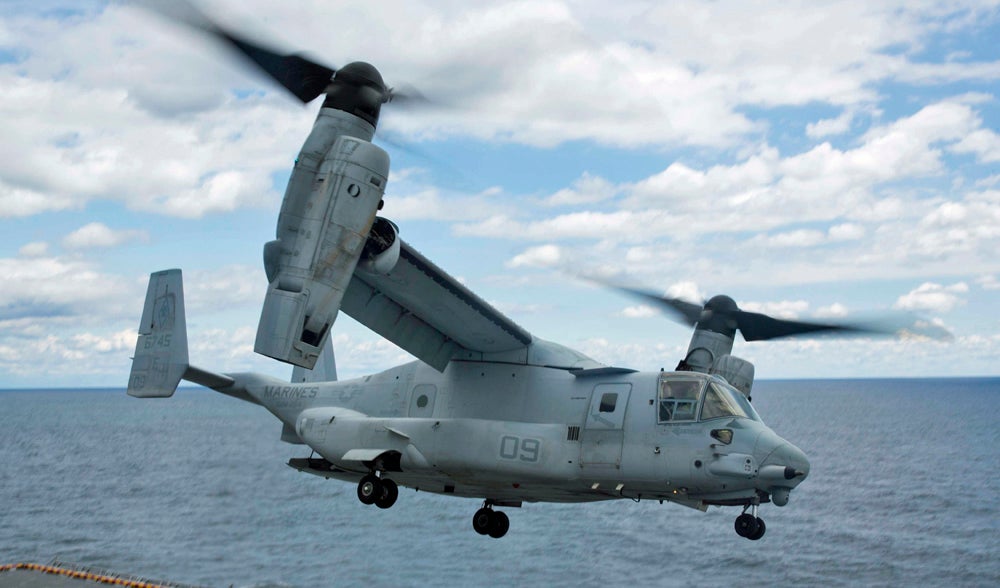
March 19, 1989 – The first flight of the Bell Boeing V-22 Osprey. When the helicopter entered military service shortly after WWII, it revolutionized ground warfare. No longer were airstrips necessary to insert troops into a combat theater, and an entirely new concept of vertical envelopment entered military doctrine. But the helicopter has its limitations, particularly in speed. At best, a helicopter is limited to about 250 mph, well under the speeds that are attainable by an airplane. The obvious solution to this problem is to design an aircraft that can take off vertically like a helicopter, but then transition to horizontal flight like an airplane. The rotors that lift the aircraft would then be used to pull it through the air. The problem of vertical or short takeoff flight (V/STOL) has been solved for smaller fighters such as the Hawker Siddeley Harrier , but V/STOL jets were never capable of carrying a useful payload of cargo or troops, though some tried . But that all changed with the Osprey, when engine and control technology finally matured enough to develop a large aircraft that could make a meaningful contribution to military logistics and transport. The genesis of the Osprey arose out of Operation Eagle Claw , the disastrous attempt to rescue the hostages being held at the American embassy in Tehran in 1980. At the time, the American fleet of large helicopters had neither the speed nor the range to carry out the rescue mission without highly orchestrated stops for fuel inside enemy territory, where an accident claimed 9 lives. What the Department of Defense desperately needed was an aircraft that could take off beyond the horizon, fly at high speed to a landing zone, then land vertically like a helicopter, and in 1981, work began on the Joint-service Vertical take-off/landing Experimental program (JVX) to fill that need. The design called for a large fuselage for troops or materiel, with turbojet engines in rotating nacelles at the end of short wings.
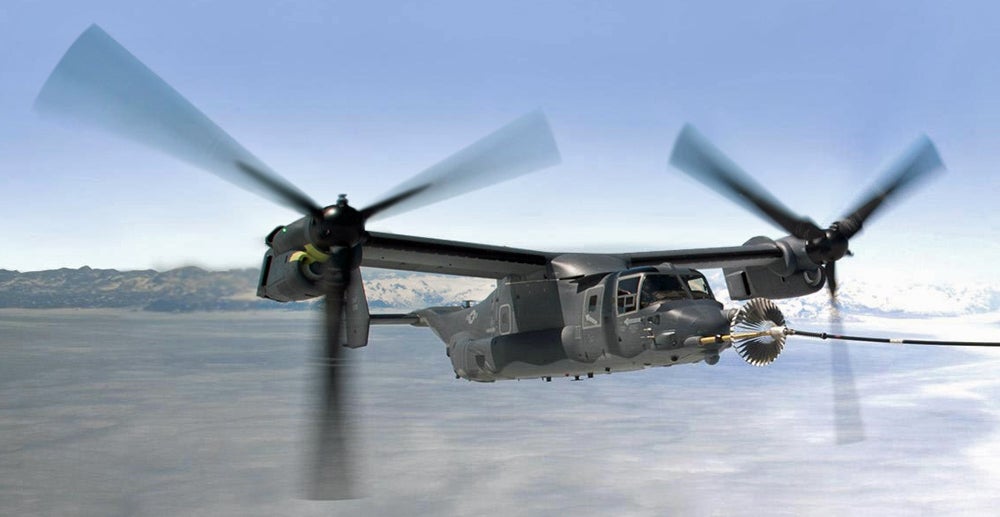
The US Navy and Marine Corps were the lead branches in the development of the JVX based on their specific operational needs, and Bell Helicopter partnered with Boeing Vertol to produce six prototypes of the Osprey. Following testing, full-scale production began in 1986. As with many modern military aircraft built entirely from scratch, cost overruns began to plague the Osprey, as well as a number of high-profile training accidents. Many believed that the Osprey was an inherently dangerous aircraft, particularly in the case of engine failure, though one engine can drive both rotors through a system of interconnected drive shafts. Pilots also had to learn how to fly the Osprey, because it was neither an airplane nor a pure helicopter. According to Bell’s chief Osprey test pilot Bill Leonard.
One of the biggest problems we’ve had in the [pilot] community is getting past the idea that it’s a helicopter that flies fast. It’s not. It’s an airplane that hovers. And if you fly the airplane like a helicopter, yes, it’s very difficult to fly as a helicopter. And if you do that, you have a very good chance of having a problem with controllability because of the way the aircraft operates. If you fly it like an airplane and you are willing to take the time to understand the capabilities of it in helicopter, it’s a very, very easy airplane to fly.
Though crashes in the early years of development led to as many as 30 deaths (resulting from 3 crashes), the Osprey has matured into an effective and safe aircraft, and the aircraft that critics once deemed unsafe now has a safety record that rivals traditional military rotorcraft. Marine Corps V-22s were first deployed to Afghanistan in 2009 where they took part in their first combat missions and continue to see service there today. The Osprey has also become valuable in special operations missions where their range and speed (up to 290 mph) aid in the insertion of special forces. They have also been flown on relief missions, and the Navy plans to use the Osprey to replace the Grumman C-2 Greyhound for Carrier Onboard Delivery (COD), and work is underway to develop the Osprey for combat search and rescue (CSAR) missions. (US Navy photo; US Air Force photo)
!!! UNKNOWN CONTENT TYPE !!!
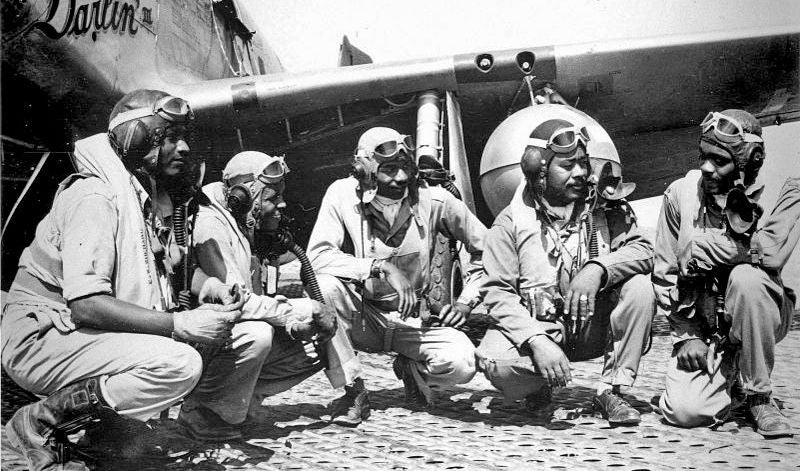
March 19, 1941 – The 99th Pursuit Squadron, better known as the Tuskegee Airmen, is constituted. If one were to look at photographs of WWII, it would be relatively easy to reach the conclusion that WWII was very much a white man’s war. However, when the war began, 2.5 million African American men registered for the draft, and at least 1 million went on to serve either as draftees or enlisted personnel in all the branches of the military. However, with a few notable exceptions, the overwhelming majority were relegated to support roles such as cooks or drivers. The US military was still a segregated organization, and blacks served in segregated units, and before the formation of the Tuskegee Airmen , no African American had ever served as a military pilot. By 1940, according to the US census, there were only 124 black pilots in all of the US. But in 1939, Congress passed the Civilian Pilot Training Act, and Tuskegee University in Alabama started training pilots as part of the Civilian Pilot Training Program . In January 1941, the War Department announced plans to create a “Negro pursuit squadron” to be manned by graduates of the Tuskegee program, and the 99th Pursuit Squadron was activated on March 22, 1941 at Chanute Field in Illinois with 271 enlisted men trained in ground support. Pilot training for the 99th began the following June. Initially, the squadron included 47 officers and 429 enlisted men, but the unit was still segregated, and even the construction contract for the base was awarded to an African American contractor. By April 1942, the 99th was considered ready for combat, and the squadron was sent to North Africa to be part of the 33rd Fighter Group. The Tuskegee Airmen, also called the Red Tails due to the distinctive red paint on the empennage of their North American P-51 Mustangs, flew their first combat mission against a strategic island in the Mediterranean Sea in the run up to the invasion of Sicily .
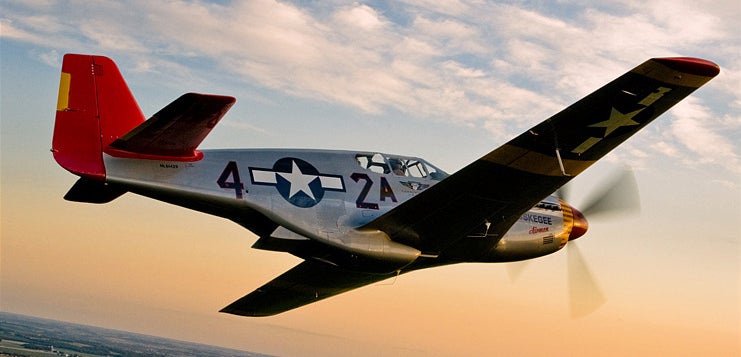
During the Italian campaign , the 99th provided close air support for the US 5th Army at Foggia and during the Battle of Anzio , and for French and Polish forces during the Battle of Monte Cassino . On July 2, 1943, 1st Lt. Charles Hall of the 99th claimed the first enemy aircraft destroyed by a Tuskegee Airman when he downed a German Focke-Wulf Fw 190 over southwestern Sicily. The 99th continued to escort bombers and provide air cover during the Italian campaign, and the unit was awarded the first of three Distinguished Unit Citations during the period June-July 1943 for its actions during the landings on Sicily. In all, the 99th flew over 15,000 sorties, and lost 66 pilots in combat, one of the lowest loss rates in the US Army Air Forces. The exemplary service of the Tuskegee Airmen, along with that of other African American servicemen, helped bring about the integration of the US military on July 26, 1948, when President Harry S. Truman issued Executive Order 9981 stating in part that “there shall be equality of treatment and opportunity for all persons in the armed forces without regard to race, color, religion, or national origin.” (US Air Force photo; photo by Max Haynes via Wikimedia Commons )
!!! UNKNOWN CONTENT TYPE !!!

March 20, 1932 – The first flight of the Boeing P-26 Peashooter. When the airplane went to war in 1914, the predominant design was the biplane, a wooden or metal framed structure covered by fabric. But as aircraft design progressed in the 1920s and 1930s, advances in construction and aerodynamics brought about the monoplane. With only one wing and no struts or braces, the reduction in drag led to increased speed, though many of the early monoplanes still used traditional frame and fabric construction techniques. The Germans had made advances with metal monoplanes as early as 1915 with the all-metal Junkers J 1 , but its weight (more than one ton) limited its performance when powered by the engines of its day. But by the 1930s, it was clear that the metal monoplane was the future of military aviation, and while the Boeing P-26 wasn’t the first metal monoplane to be considered by the US Army Air Corps, it was the first to enter production and service. Development of the P-26 began in 1931 with an internally funded Boeing project known as the Model 248. For that aircraft, the Army supplied the engines and instruments, while Boeing built the airframe. The 248, while a monoplane, still employed many of the design elements found in earlier aircraft, such as fixed landing gear and external wire bracing to keep the wings from buckling. Its small wings also led to an unacceptably high landing speed, which caused a number of crashes, and the Peashooter’s short nose meant that it had a tendency to pitch forward on landing, injuring or killing the pilot. These problems were addressed by the addition of flaps to lower the landing speed, and a raised headrest to protect the pilot should the plane flip over.
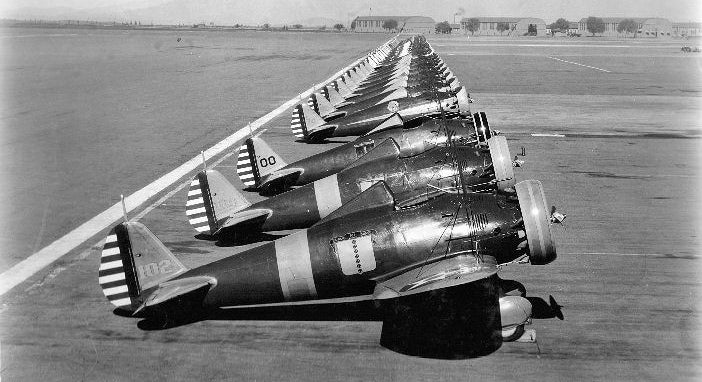
Two different engines were used in the P-26A and P-26B before the Army settled on a carbureted Pratt & Whitney R-1340 radial with Townend ring to help reduce drag. The USAAC ordered 111 P-26As, followed by orders for the improved B and C models, and took delivery of the first Peashooters in 1934. The carbureted engines of the later models were then modified to accept fuel injection. At the time of its introduction, the Peashooter was the fastest fighter in the American inventory with a top speed of 234 mph. But rapid advances in aircraft design in the 1930s soon rendered the P-26 somewhat of an anachronism. Fighters such as the Messerschmitt Bf 109 and Hawker Hurricane were just three years away, much more modern aircraft with enclosed cockpits, retractable landing gear and cantilevered wings . Nevertheless, the P-26 proved easy to fly, and it remained in service until the outbreak of WWII. Though the Peashooter never saw combat with American forces, fighters exported to China saw action against the Japanese in 1937, where they were responsible for downing a handful of bombers, and members of the Philippine Army Air Corps had limited success against Japanese fighters in 1941. A total of 141 Peashooters of all variants were produced, and it was the last fighter developed by Boeing until the company acquired McDonnell Douglas in 1997. (US Air Force photos)
!!! UNKNOWN CONTENT TYPE !!!
!!! UNKNOWN CONTENT TYPE !!!
!!! UNKNOWN CONTENT TYPE !!!
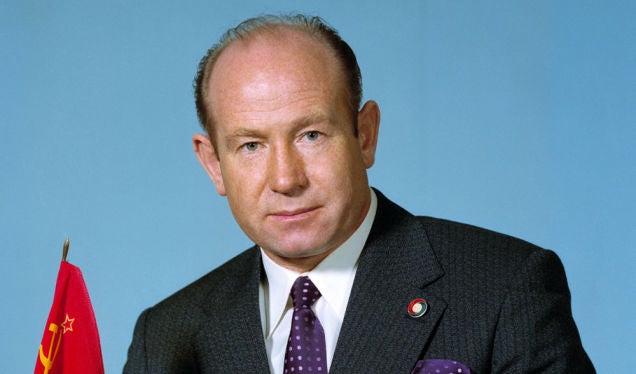
March 18, 1965 – Cosmonaut Alexei Leonov becomes the first person to “walk” in space. Leonov was one of 20 Soviet Air Force pilots selected as the first cosmonauts in 1960, and his first flight to space was on board Voskhod 2 as part of Russia’s manned space program. During Leonov’s 12-minute-long extravehicular activity (EVA), a defect in the design of his spacesuit caused it to inflate to the point where he could not re-enter the capsule. He had to release a pressure valve on the suit and only then just barely made it back inside. Leonov returned to space for the second and last time in 1975 as commander of Soyuz 19, part of the Apollo-Soyuz Test Project in which a Soviet and an American space capsule docked together in space to mark the symbolic end of the Space Race . (NASA photo)
!!! UNKNOWN CONTENT TYPE !!!

March 18, 1961 – The first flight of the Tupolev Tu-28, a long-range interceptor introduced to the Soviet Air Force in the late 1960s and the largest interceptor to fulfill that role ever to enter service. To protect Russia’s vast territory, Tupolev designed a supersonic interceptor with an enormous fuel load, radar, and the best air-to-air missiles available at the time. The Tu-28, also called Tu-128 by the Soviets, was never intended as a dogfighter, rather it’s mission was to intercept American bombers such as the Boeing B-52 Stratofortress . The Tu-28 had an estimated top speed of Mach 1.5 and a range of 1,600 miles, but could not fly above 15,600 feet when armed. Just under 200 were built, and the type was retired in 1990. ( US Navy photo )
!!! UNKNOWN CONTENT TYPE !!!
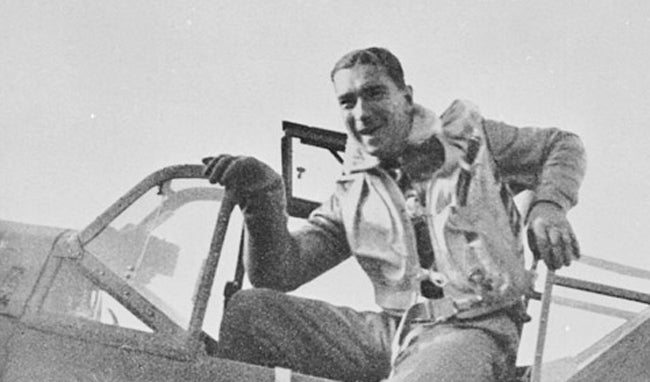
March 18, 1913 – The birth of Werner Mölders, a WWII Luftwaffe fighter pilot and the leading German ace of the Spanish Civil War . During Mölder’s brief career, he became the first fighter pilot in history to achieve 100 combat victories, and was also instrumental in the development of the finger-four combat formation. After fighting in the Spanish Civil War, Mölders fought in the Battle of France and Battle of Britain before being sent to the Eastern Front during Operation Barbarossa , the German invasion of Russia. In July 1941, Mölders was removed from combat and named Inspector General of Fighters, where he oversaw the training and tactics of German fighter pilots. On November 22, 1941, Mölders was flying as a passenger in a Heinkel He 111 to attend the funeral of Ernst Udet when the plane crashed near Breslau while attempting a landing in bad weather. Mölders was 28 years old at the time of his death. (Photo via the RAF Museum )
!!! UNKNOWN CONTENT TYPE !!!

March 19, 1964 – Geraldine Mock becomes the first woman to fly around the world. Flying a single-engine Cessna 180 Skywagon (N1538C) named Spirit of Columbus , Mock took off on March 19 from Columbus, Ohio and completed the flight on April 17 after 29 days. The flight included 21 stopovers and covered 22,860 miles. In recognition of this feat, Mock was awarded the Louis Blériot Medal from the Féderation Aéronautique Internationale in 1965. She later published a book about her trip in 1970 titled Three-Eight Charlie . Mock also holds numerous speed and distance records for a woman pilot, and was the first to fly across the Pacific Ocean in a single-engine aircraft and the first to cross both oceans. Her Cessna now resides at the Smithsonian’s Steven F. Udvar-Hazy Center . (Photo by Sheldon Ross/Columbus Dispatch via Smithsonian Institution )
!!! UNKNOWN CONTENT TYPE !!!
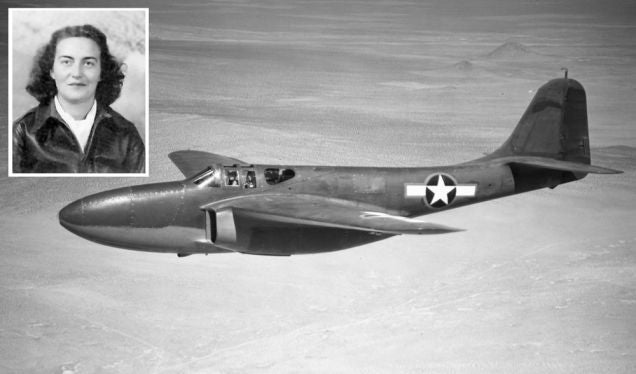
March 20, 2008 – The death of Ann Baumgartner, the first American woman to fly a jet fighter.
Born in Augusta, Georgia in 1918, Baumgartner was a pilot with the
Women Airforce Service Pilots
(WASP) program which was tasked with ferrying new aircraft from factories in the US to points of embarkation around the country. In February 1944, Baumgartner transferred to Wright Field in Ohio on a temporary assignment to test aeromedical equipment, eventually becoming assistant operations officer for the WASPs at Wright Field. On October 14, 1944, Baumgartner flew the
Bell YP-59 Airacomet
, America’s first jet fighter, as part of her testing duties. Following the disbanding of the WASPs in 1944, Baumgartner continued to work as a flight instructor for United Airlines.
(P-59 photo via US Air Force; Baumgartner photo author unknown)
!!! UNKNOWN CONTENT TYPE !!!

March 20, 1991 – Cuban Air Force pilot Maj. Orestes Lorenzo Perez defects to the US flying his Russian-built fighter to NAS Key West in Florida.
While on a training mission, Perez turned his
Mikoyan-Gurevich MiG-23BN
toward Florida where he landed uncontested. To the embarrassment of the US Air Force, defense radars failed to pick up the airplane and no fighters were scrambled. The MiG was eventually returned to Cuba, and Perez was given asylum in the US. The following year, Perez flew back to Cuba in a
Cessna 310
and landed on a busy highway to pick up his wife and two sons who had been told that he would be returning for them. Orestes then flew back to the US, where his family was also granted asylum.
(Photo from Orestes Collection via
20th Century Aviation Magazine
)
!!! UNKNOWN CONTENT TYPE !!!
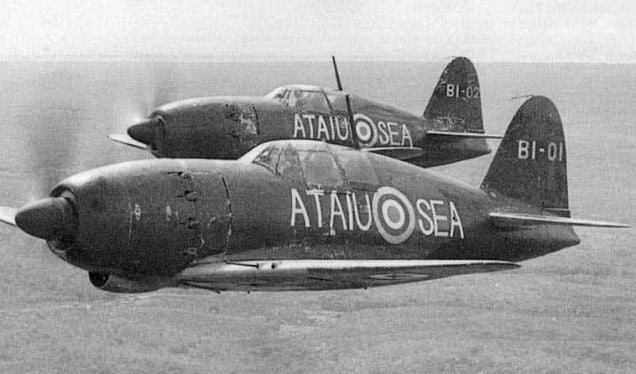
March 20, 1942 – The first flight of the Mitsubishi J2M,
a Japanese fighter nicknamed
Raiden
(Thunderbolt) and given the Allied reporting name
Jack
. The
Raiden
was designed by
Jiro Horikoshi
, who had also designed the
A6M Zero
, and was built to be a local defense interceptor to protect the Japanese home island from American bombers. The J2M first saw action in 1944 during the
Battle of the Philippine Sea
, but its lack of a turbocharger meant that it had difficultly engaging the high-flying
Boeing B-29 Superfortress
, though its armament of four cannons was potent, and it was occasionally effective in diving attacks. A total of 671
Raidens
were built, and it was retired at the end of the war.
(Captured J2Ms following the war, UK Government photo)
!!! UNKNOWN CONTENT TYPE !!!
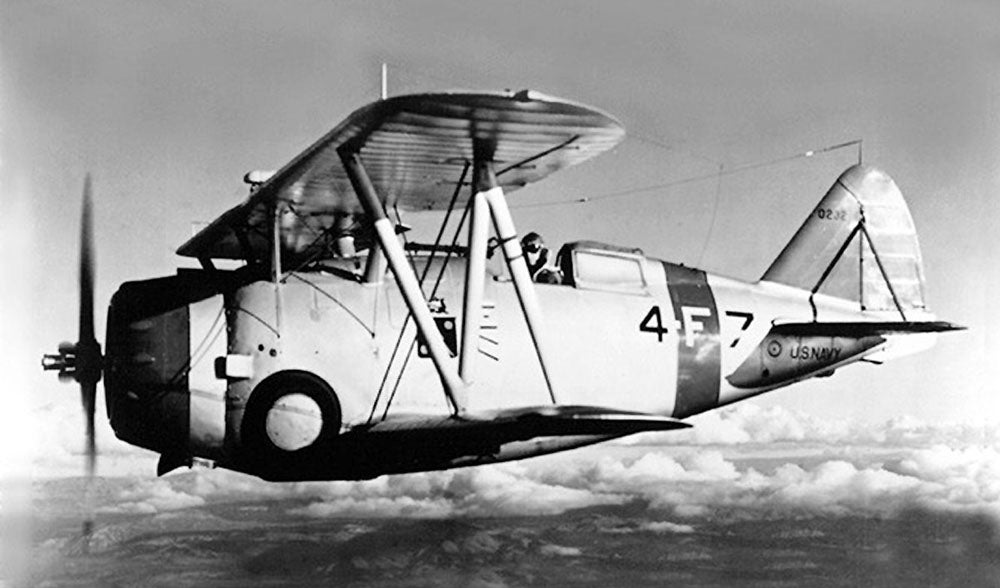
March 20, 1935 – The first flight of the Grumman F3F,
the last biplane fighter delivered to the US Navy. Designed to replace the
Grumman F2F
, the F3F entered service in 1936, but was removed from frontline service in 1941 at the beginning of the war. It was replaced by the
Brewster F2A Buffalo
, though a number of F3Fs continued to fly in a training role. The F3F also served the US Army Air Force as a trainer with the designation UC-103. While the F3F performed the bulk of its service before the war, it formed the developmental basis for the
Grumman F4F Wildcat
, the mainstay Naval fighter in the early years of WWII.
(US Navy photo)
!!! UNKNOWN CONTENT TYPE !!!
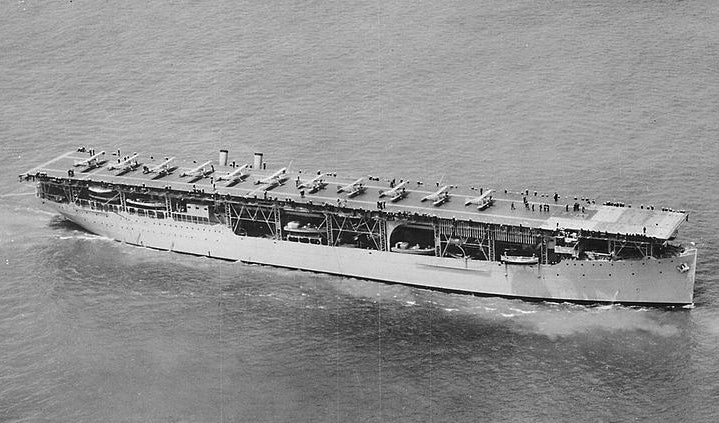
March 20, 1922 The US Navy commissions the USS Langley (CV-1) , its first aircraft carrier. Converted from the collier USS Jupiter , Langley was also the US Navy’s first turbo-electric-powered ship . Langley was converted at the Navy Yard in Norfolk, Virginia and named after American aviation pioneer Samuel Pierpont Langley . The first plane to fly from her deck was a Vought VE-7 flown by Lt. Virgil Griffin on October 17, 1922. After serving off the California coast for 12 years, Langley was converted to a seaplane tender (AV-3) and served in the early part of WWII, but had to be scuttled following an attack by Japanese dive bombers on February 27, 1942. (US Navy photo)
!!! UNKNOWN CONTENT TYPE !!!
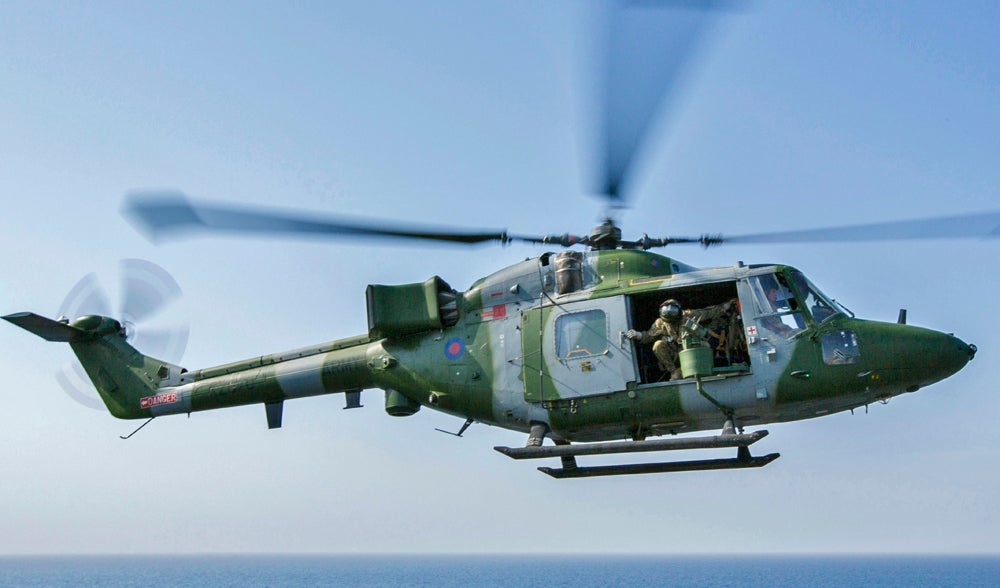
March 21, 1971 – The first flight of the Westland Lynx,
a multi-purpose helicopter designed and built by Westland Helicopters in England as a replacement for the
Westland Scout
and
Westland Wasp
. Originally built as a utility helicopter for both civilian and military use, the Lynx was further developed into armed gunship and antisubmarine warfare (ASW) variants. The Lynx entered service with the British Army in 1971 and currently serves with the British Army and Royal Navy, with export versions operated by the French Navy and German Navy. Still in production, more than 450 have been built to date, and they have seen action in the Iraq War and in Afghanistan.
(US Navy photo)
!!! UNKNOWN CONTENT TYPE !!!
!!! UNKNOWN CONTENT TYPE !!!
!!! UNKNOWN CONTENT TYPE !!!
!!! UNKNOWN CONTENT TYPE !!!
!!! UNKNOWN CONTENT TYPE !!!
!!! UNKNOWN CONTENT TYPE !!!
!!! UNKNOWN CONTENT TYPE !!!
If you enjoy these Aviation History posts, please let me know in the comments. And if you missed any of the past articles, you can find them all at Planelopnik History . You can also find more stories about aviation and aviators at Wingspan and Planes You’ve (Probably) Never Heard Of .
!!! UNKNOWN CONTENT TYPE !!!
 "For Sweden" (rallybeetle)
"For Sweden" (rallybeetle)
03/21/2017 at 12:38, STARS: 5
The V-22 succeeded because it has a couple huge fans.
 "ttyymmnn" (ttyymmnn)
"ttyymmnn" (ttyymmnn)
03/21/2017 at 12:52, STARS: 1

 "MonkeePuzzle" (monkeypuzzle)
"MonkeePuzzle" (monkeypuzzle)
03/21/2017 at 12:54, STARS: 2
getting mad props
 "McMike" (mcmike)
"McMike" (mcmike)
03/21/2017 at 12:58, STARS: 1
That Cuban pilot’s story is great.
One last sortie.
!!! UNKNOWN CONTENT TYPE !!!
 "Chariotoflove" (chariotoflove)
"Chariotoflove" (chariotoflove)
03/21/2017 at 13:16, STARS: 1
The guy had balls to do what he did the first time, but the second? Unbelievable.
 "f86sabre" (f86sabre)
"f86sabre" (f86sabre)
03/21/2017 at 13:20, STARS: 2
I always was under the impression that Leonov was a good dude.
Have you found this podcast yet? Lots of good, in depth aviation and space stuff.
 "ttyymmnn" (ttyymmnn)
"ttyymmnn" (ttyymmnn)
03/21/2017 at 13:22, STARS: 0
Thanks for the link. I’ll check it out.
 "McMike" (mcmike)
"McMike" (mcmike)
03/21/2017 at 13:49, STARS: 1
At full afterburner it would have only taken him 17 minutes to get to Key West.
The second flight was more impressive to me. If caught he would have been executed.
 "Chariotoflove" (chariotoflove)
"Chariotoflove" (chariotoflove)
03/21/2017 at 13:59, STARS: 0
Agreed.